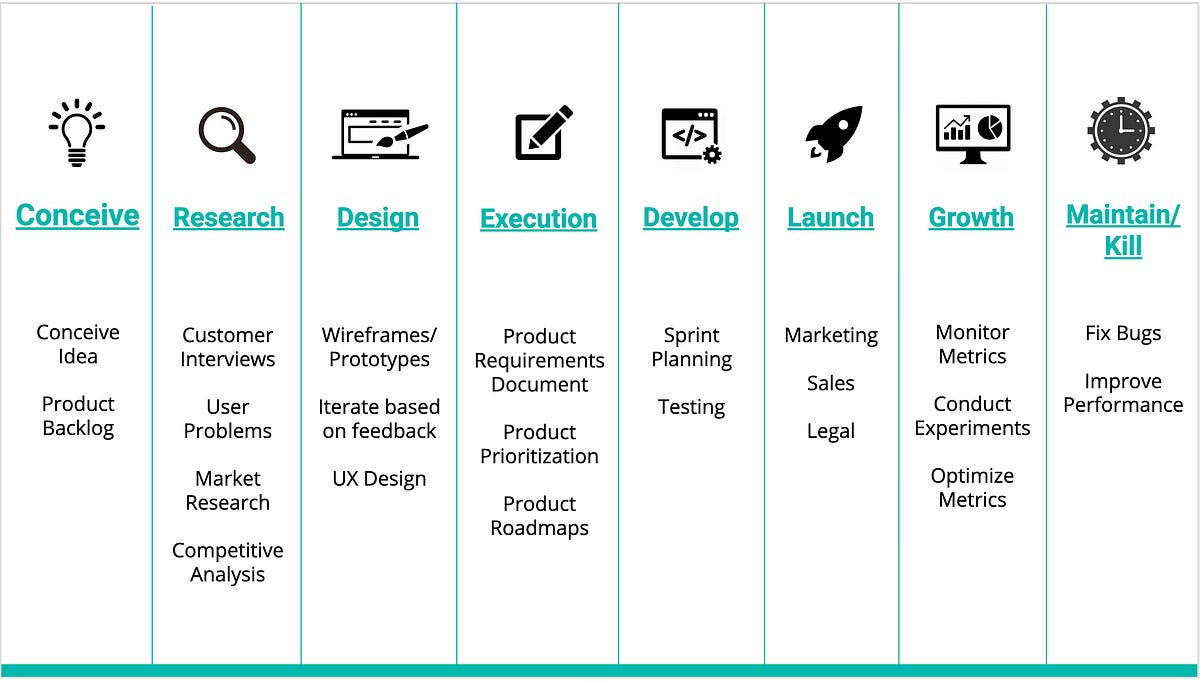Product Management Bootcamp Notes - 1 - Customer Research
Notes while going through a Product Management Bootcamp on getting new ideas and researching your customers


I'm currently going through a Product Bootcamp run by Anusha Jain, with my wonderful partner Madhavi Swamy, and learning the various aspects of Product Management. Instead of creating personal notes, I'm doing a bit of #learninginpublic and sharing all that I have learned (with screenshots) on my blog.
I'm going to write in a very notesy way so there will be slightly lesser story-telling here, although I will still try to maintain that tone as much as possible.
The Beginning
We first talk about the various stages in Product Management.

New Ideas
For conceiving new ideas, these ideas can come from:
- Employees
- User Feedback - social media, emails, forms
- Clients
- Competitors
- Metrics/User Behavior
But, we still need to validate the ideas that we come up with. And that requires User Research.
Before getting started with our case study, we were paired into teams of 3. For this case study, we were paired with Suyash Maheshwari who was super helpful during the persona creation and User journey mapping part due to his extensive experience in Business Analysis.
For our case study, we were told to choose an existing product so that we don't have to spend time on novel research and get time to work on User Research and Personas instead. I chose to go with the Roomba because it's the product that I most wish existed in a mass-market format in India. Some variants of it exist, but they aren't widely used. So I wanted to go ahead and research why people aren't going for a robotic solution for their floor cleaning.
User Research
For this section, I'll quickly go over a few terminologies and Research techniques we need to quickly understand. User Research consists of either conducting Interviews (small-scale but intensive) or surveys (large-scale but not intensive).
The purposes of User Research are:
- Exploratory (Customer Discovery) - to gain understanding of users, for new feature development .
- Validation - you have a rough idea and a problem hypothesis.
- Efficiency - to make incremental improvements to existing product.
In my case, finding users to research was easy. I saw my mother work everyday (we contribute to household work of course, but the majority of work was done by her), and I know other friends who either live alone or live an a household where no one might have time to do household chores. So I decided to divide user interviews between me and Madhavi, and we interviewed ~3 people each. I'll talk about the results of these interviews in the User Personas section.
User Personas
The most efficient way to do User Research is to create 3-7 hypothetical target User Personas for your feature or your app and validate them via user interviews/surveys.
- Personas help you get into the mind of your user and identify with them
- They help you clearly understand the goals and behaviors of different users
More likely, preliminary surveys help in finding User Personas and you drill down on them using User Interviews.
Customer Interviews
Never introduce your idea or hypothesis
General Rules:
1. Ask open ended questions, that cannot be answered with a yes or no.
2. Don’t ask leading questions.
3. Don’t ask hypothetical questions.
4. Don’t ask users about future plans or opinions.
5. Let them go off-tangent.
6. Get excited to hear things that you don’t want to hear.
7. Don’t show your opinions
8. Use this line - “That’s interesting, tell me more”.
User Surveys
1. Keep it short, every question should have a specific purpose
2. Ask broad questions before specific questions
3. Don’t ask biased or leading or hypothetical questions
4. Don’t ask open ended questions - instead ask rating based questions.
To get started with User Interviews, you first need a set of User Personas to test them against, so the User Personas we decided to create were:
- A bachelor living with roommates.
- A working couple who divide household work.
- A rich household with full-time househelp.
Now, for our product, how can we position it or ideate it that it would be useful for all of them? But before that, would they even need a product? To understand this, we had to do user interviews. For this, me and Madhavi divided the users we would interview.
So, the users I ended up interviewing were:
- my Mother.
- a friend who lives alone but takes great care of his house.
- a friend who lives in a large house but everyone is a working professional.
And Madhavi interviewed:
- a friend of hers who lives with roommates.
- her mother.
- a full-time househelp.
Here's the transcript for one of those interviews with Madhavi's mum:
- Do you care about keeping your house clean? How do you handle housework - Yes, cleaning is necessary to keep the space safe from allergens and dirt and messy dirty homes account for bad health. Handle by cleaning and disinfecting the house space themselves
- How many times a week do you do it? - The cleaning work is done on a daily basis - floors are cleaned and disinfected daily and the rest of the house i.e. walls, wardrobes, decorative items, shelves, tables etc. are cleaned once a week.
- What problems do you face? - Have to clean with bare hands, hands become dry, itchy and scaly. The disinfectants sometimes can also cause chronic skin damages. Health issues like back, neck and knee pain also arise for middle to old aged people. Some even have to deal with allergies corresponding to the dirt and dust
- What have you done to solve those problems? (have they tried to search for a solution?) - Hired a maid, purchasing cleaning machines, hiring cleaning agencies
- Have you made any recent purchases to solve housework? What are they? - Yes, A vacuum cleaner, Floor mop.
- Have these solutions solved your problem - Not entirely, the machines help but they cannot reach certain areas of the house like corners, so that have to be manually cleaned. The machines are not economical for the lower economic class people.
In conclusion, most interviews went similarly. Although some people are intrigued by having an automated machine like a Roomba in their house, most are content with domestic help itself since it costs them < Rs. 1500 a month to get cleaning and cooking done 7 days a week. So it doesn't sound like there's a real problem to solve here. Perhaps for the next case study, we'll choose a different problem to solve.
Customer Journey Mapping
The final part of customer research comes with Customer Journey Mapping. They document a customer’s journey from the very first interaction to the last. It helps identify important gaps/inefficiencies in a product.
To have a look at the User Personas and Customer Journey Map we built, have a look at the Google Doc we built here.
Thanks for reading this summary! I'll catch you next week with the next set of notes for the sessions. You can subscribe to this newsletter or follow me on Twitter @thewritingdev.
